It’s late Spring and the Texas Hill Country has rarely looked better thanks to badly-needed rainfall in May. Here at Casa Fire Ant we recorded almost seven inches of rain in May, and more is in the forecast.
This is also the time of year when the next generation of wildlife comes on the scene. Turtles — red-eared sliders, river cooters, spiny soft-shell turtles — make their way out of the creek and into vacant lots (and, sometimes, residential lawns) to dig nests and lay eggs. Whitetail deer drop fawns, and fledgling birds escape their nests to try out their rapidly developing wings. Juvenile snakes and lizards begin to appear.
Following are some observations we’ve made over the past few weeks, highlighting the variety of fauna that we’re privileged to encounter. Note that there are a couple of snake photos at the end of this post, so if those are not your cup of tea, you’ll have ample notice to avoid them.
Lizards Of Unusual Size
There are at least five species of lizards around our property: Texas spiny lizards (Sceloporus olivaceus), six-lined racerunners (Aspidoscelis sexlineatus), house geckos (Hemidactylus), Carolina anoles (Anolis carolinensis), and Little brown skinks (Scincella lateralis). If you live in Central Texas, you’ve probably encountered the first four, but the last one might be a bit more mysterious. I’ve previously written about all but the last one.
Fans of The Princess Bride know about ROUSes (Rodents of Unusual Size), but I want to talk about LOUSes. While the former were notable because of their hugeness, we have a population of lizards that are extremely tiny.
Little brown skinks (it’s a name as well as a description!) are among the tiniest lizards in North America. Most are less than five inches long, and half of that length is their tails.
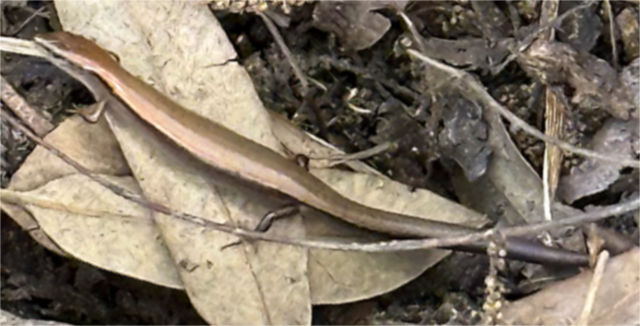
These little guys are devilishly difficult to photograph in the wild. They’re very skittish, and a quick to hide in the leaf and twig litter that’s found in the non-manicured landscape on the other side of our back fence. They blend in really well with their habitat…can you spot the lizard in the following photo?
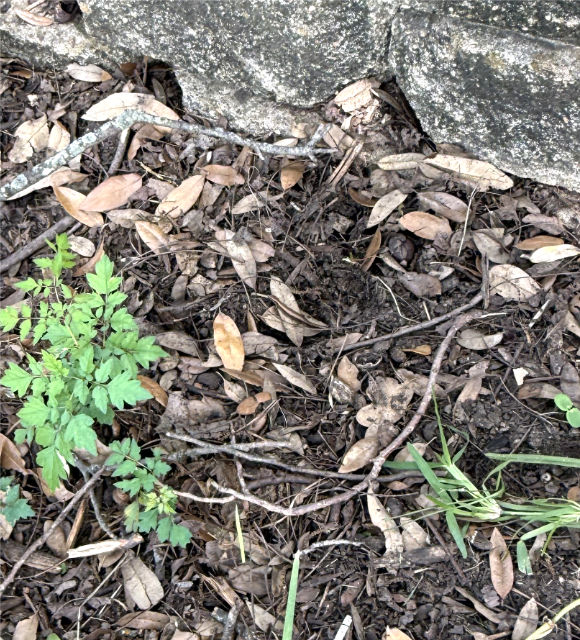
It’s easy to miss their short legs, and given the way they wriggle, you would be forgiven if at first glance you thought that the movement in the ground clutter was caused by a tiny snake.
These little guys are good to have around as they eat pill bugs, spiders, wood lice, and other small insects.
Fawning over baby deer
Last weekend, I was getting ready to mow the small “natural” area outside our fence and backing up to the creek. I was picking up rocks and branches, keeping an eye out for snakes (more about that in a minute), and almost didn’t notice what was resting peacefully a few feet away.
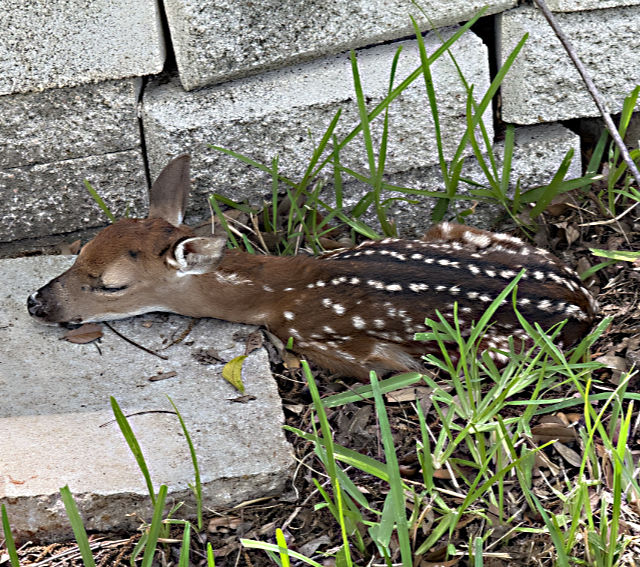
This tiny whitetail fawn was resting so motionlessly next to a retaining wall that for a brief moment, I wondered if it was still alive. Thankfully, it was.
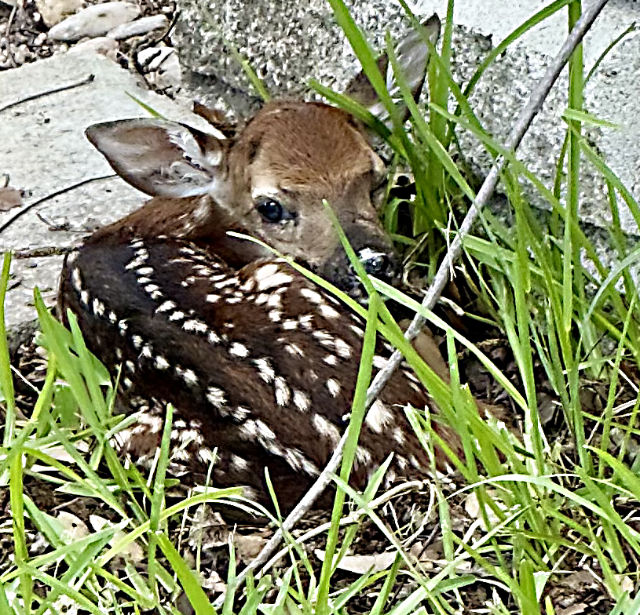
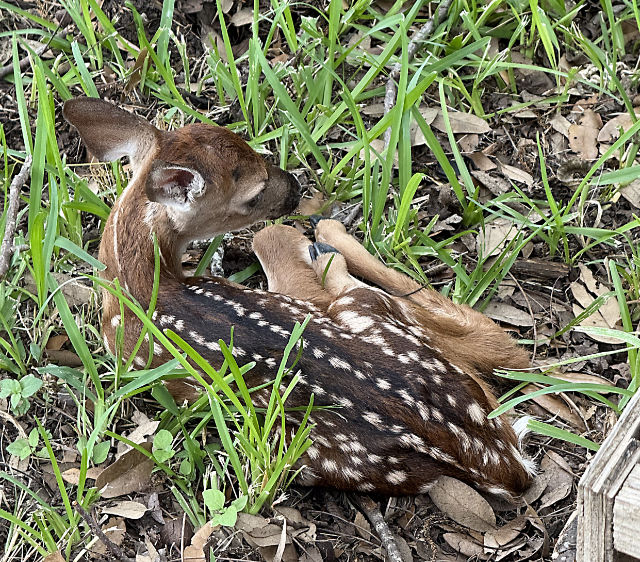
After taking a few photos from a distance, I put my mowing plans on hold. I knew that the mom would eventually return and lead her little one to parts unknown. I wanted to capture that scene, so I set up a trail camera on a tripod a few yards away. When I checked a couple of hours later, the fawn was gone, and I hurried to download the photos from the trail camera. I was surprised and disappointed to find that the camera captured absolutely nothing of the fawn’s exit from the premises. Whitetail deer are apparently part ninja.
Fun with Fledglings
We have a metal yucca (or, possibly, an agave) on our front porch and it provides an attractive habitat for a varierty of critters, mostly insects and spiders.
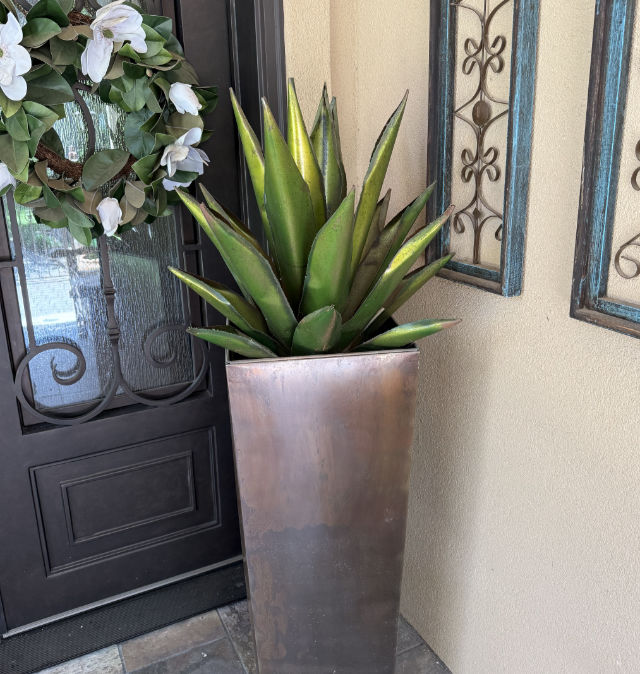
But this year, Carolina wrens (Thryothorus ludovicianus) decided to build a nest in the planter, recognizing the security provided by the spiky surroundings.
These birds are quite common in the eastern part of the United States. Here in Central Texas, we’re close to the western edge of their distribution, but we do have a large population. Here’s a sample of their call; see if you recognize it:
They can actually be quite annoying, especially when they’re just outside one’s bedroom window in the early morning. Anyway, I’m not complaining (much). The reason I’m including them in this post is that three or four of the fledgling wrens emerged suddenly from the planter like avian popcorn, landing on the porch, and fluttering a few feet at a time while they tried out their wings.
They have something in common with the Little brown skinks in that they’re rarely stationary and they move very quickly — it’s a pretty effective anti-predator behavior — and difficult to photograph. I managed to get just one photo barely acceptable picture.
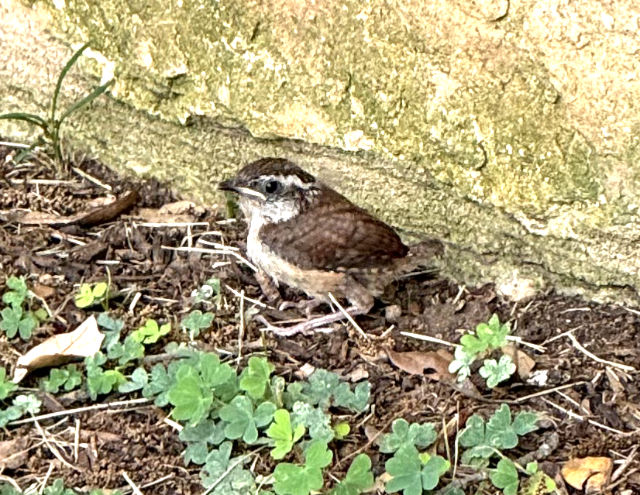
We weren’t crazy about having a bird nest on our front porch, but at least it wasn’t a barn swallow nest (although we could use their help with mosquito control).
Honeybee Ecstasy
I’m going to wrap this up with a snake encounter (you’ve been warned!) but before we get to that, let me share a different kind of wildlife sighting. As I’ve previously mentioned, our magnolia trees are finally beginning to bloom. Beside being beautiful, those blooms have a pleasing odor that’s also quite attractive to a variety of pollinators, and in particular, Western honey bees (Apis mellifera).
As the flower begins to wither (they’re very short-lived) the center portion that contains the reproductive components disintegrates. The flower’s stamens, which contain pollen, drop away and are sometimes collected on one of the petals…and this is where the honey bees come into the picture. That pollen must be the apian equivalent of catnip, because it sends the bees into the kind of ecstatic writhing that would get a movie banned from our local movie theater if it involved humans. Here’s a short, slow-motion video I took that demonstrates this behavior, which, frankly, I find hilarious.
I can only assume that this behavior is the means by which the bees collect the pollen before returning to their hive. In any event, I’m thrilled not only because our trees are finally blooming, but also because they’re playing an important ecological role by attracting pollinators.

We’ve now come to the part of the program that some of you can do without. I’m going to describe a recent encounter with a juvenile Northern cottonmouth (Agkistrodon piscivorus), aka water moccasin.
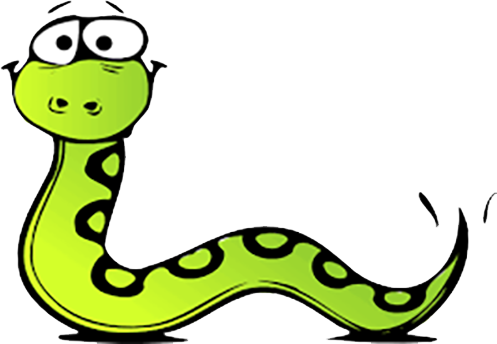
Our home backs up to Pecan Creek, a live water creek, and it’s home to a wide variety of reptiles, amphibians, fish, and even some mammals (really; there’s a family of beavers living somewhere upstream and they occasionally wander into our neighborhood and chew on small trees). And, of course, when we’re talking about reptiles, the conversation generally turns to snakes.
Pecan Creek hosts a couple of non-venomous (i.e. harmless) species, namely plain-bellied water snakes (Nerodia erythrogaster)and diamondback water snakes (Nerodia rhombifer). Both species suffer from being mistaken for the third species of water snake, the cottonmouth, and people who aren’t able to distinguish the harmless from the venomous often end up killing the wrong species. They can look very similar from a distance, especially the adults.
However, the juvenile cottonmouth is quite distinctive and if it’s mistaken for another snake, it will be mistaken for a copperhead, another venomous species. The two species are closely related, although the venom of the cottonmouth is more toxic than that of a copperhead. The same antivenom is effective for bites from both species.
Take a look at the following photo and you’ll see the possible confusion:
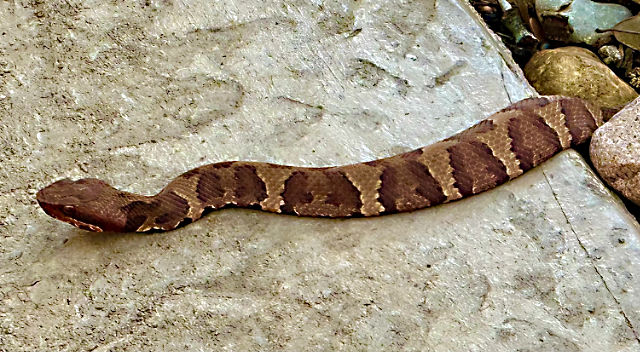
This small — perhaps 18″ in length — cottonmouth had crawled up from the creek following a heavy rain. I assume it was looking for frogs, a staple in its diet, along with fish, insects, and even small turtles.
Those bright colors and distinctive patterns will fade as the snake ages, generally eventually turning almost solid black, or at least very dark.
It was unappreciative of my presence, as evidenced here:
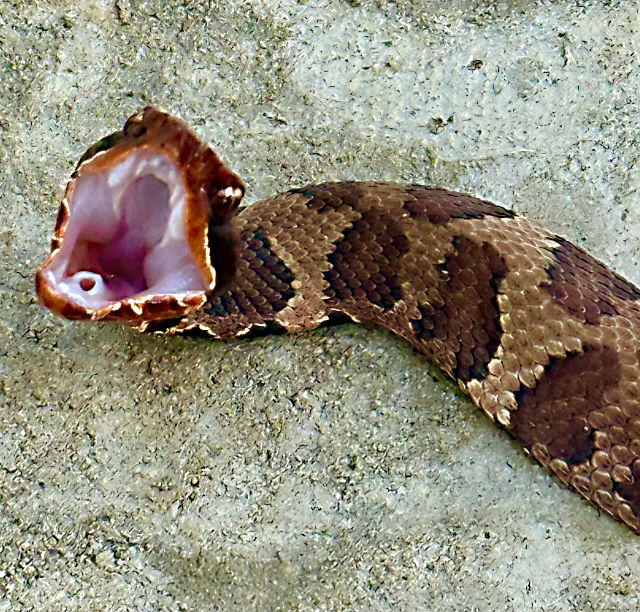
As soon as it spotted me, it displayed the pale interior of its mouth in a behavior known as gaping. If you look closely, you can make out the two fangs which are normally shielded from view. This gaping behavior is a defense mechanism designed to warn away potential predators, and it’s one reason why cottonmouths have the unearned reputation for being aggressive.
Incidentally, that hole in the front of the bottom jaw is the snake’s glottis, which leads to the trachea. Snakes can shift those organs in such a way that they can continue to breathe while swallowing prey that’s much larger than themselves.
We stared at each other for a few minutes until the youngster decided I wasn’t a threat. It made a quick u-turn and slithered back toward the creek.
This encounter was a good reminder to watch our step. The snake had come up with a few feet of where the fawn would rest a few days later. I do realize that my decision to not kill it will be controversial for some, and I don’t judge those who feel it’s appropriate to eradicate venomous snakes wherever they are found, especially if they fear for pets and children. I urge folks to get educated about the differences between harmless and venomous snakes so at least the former will stand a chance at survival. They are an integral part of the Texas Hill Country ecology.
Discover more from The Fire Ant Gazette
Subscribe to get the latest posts sent to your email.

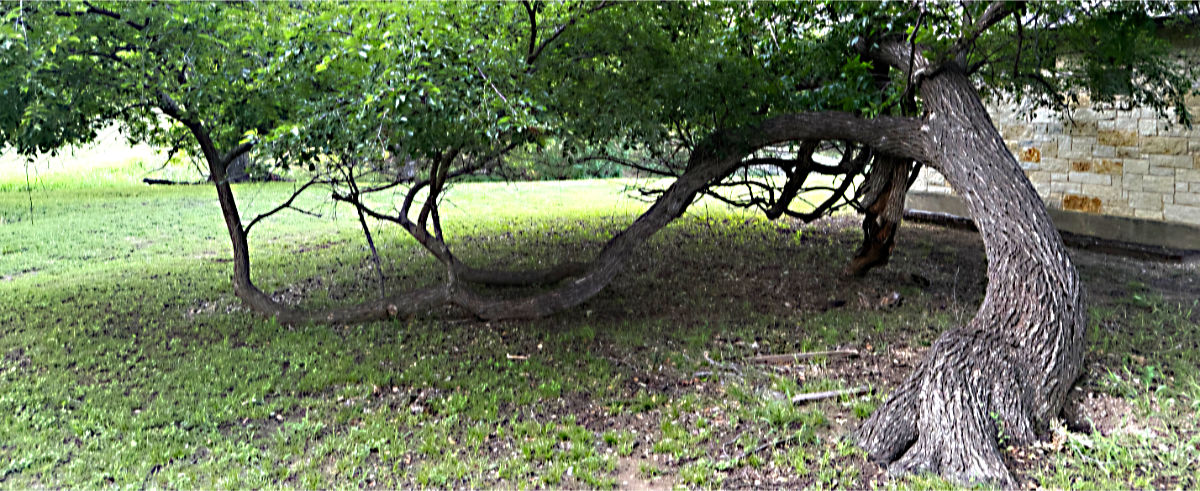
Nice pics; thanks for sharing.
Thanks, Rob…glad you enjoyed it!
What amazing pictures, Eric! And I thought the honey bee video a treasure!
Thanks, Toni! I agree…those bees were the bees knees! 🤣
It has been great weather for all of the critters! We have a spiny lizard somewhere in our house. He ran in one day when we left the door open for some fresh air. I’ve offered him a job as pest controller, but he won’t come out to make a deal.
Lee, funny you should say that. We had a spiny lizard living in our garage for more than a year, and it did a great job of controlling the insect population. In fact, we’d occasionally catch a bug inside the house and I’d take it to Jim Morrison (IYKYK) and he’d dart out from under the treadmill and devour it.
I loved the wonderful pictures of the fawn and the video of the bees. I appreciate the warning about the snake and decided to be brave and educate myself on identifying it. Thank you for the information. I will be so careful by the creek. I would never attempt to kill a snake cause I would be gone in a flash!
Thanks, Audrey! And try not to be paranoid about being near the creek. Just be alert…as you would be driving on streets and highways…and you’ll be fine!
I commend you for your resolve to get educated about the critters with whom we coexist. 👍
I love hearing of your nature exploits, Eric. I missed them for a couple months.
Hey, Dave…I’ve missed hearing from you…hope you’re doing well!
Lovely photos and interesting facts.
Thanks, Brenda…and welcome to the Gazette! 🤗